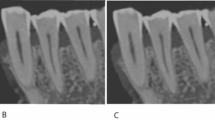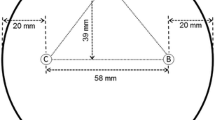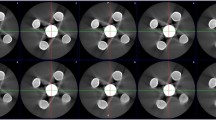Abstract
Purpose
The goal of this study was to investigate whether different computed tomography (CT) energy levels could supply additional information for the differentiation of dental materials for forensic investigations.
Methods
Nine different commonly used restorative dental materials were investigated in this study. A total of 75 human third molars were filled with the restorative dental materials and then scanned using the forensic reference phantom in singlesource mode. The mean Hounsfield unit values and standard deviations (SDs) of each material were calculated at 120, 80 and 140 kVp.
Results
Most of the dental materials could be differentiated at 120 kVp. We found that greater X-ray density of a material resulted in higher SDs and that the material volume could influence the measurements.
Conclusion
Differentiation of dental materials in CT was possible in many cases using single-energy CT scans at 120 kVp. Because of the number of dental restorative materials available and scanner and scan parameter dependence, as well as the CT imaging artifacts, the identification (in contrast to differentiation) was problematic.





Similar content being viewed by others
References
Kirchhoff S, Fischer F, Lindemaier G, Herzog P, Kirchhoff C, Becker C, et al. Is post-mortem CT of the dentition adequate for correct forensic identification?: Comparison of dental computed tomograpy and visual dental record. Int J Legal Med. 2008;122:471–9.
Thali MJ, Markwalder T, Jackowski C, Sonnenschein M, Dirnhofer R. Dental CT imaging as a screening tool for dental profiling: advantages and limitations. J Forensic Sci. 2006;51:113–9.
Dirnhofer R, Jackowski C, Vock P, Potter K, Thali MJ. VIRTOPSY: minimally invasive, imaging-guided virtual autopsy. Radiogr Rev Publ Radiol Soc N Am Inc. 2006;26:1305–33.
Pittayapat P, Jacobs R, De Valck E, Vandermeulen D, Willems G. Forensic odontology in the disaster victim identification process. J Forensic Odontostomatol. 2012;30:1–12.
Baglivo M, Winklhofer S, Hatch GM, Ampanozi G, Thali MJ, Ruder TD. The rise of forensic and post-mortem radiology—analysis of the literature between the year 2000 and 2011. J Forensic Radiol Imaging. 2013;1:3–9.
Coursey CA, Nelson RC, Boll DT, Paulson EK, Ho LM, Neville AM, et al. Dual-energy multidetector CT: How does it work, what can it tell us, and when can we use it in abdominopelvic imaging. Radiographics. 2010;30:1037–55.
Ruder TD, Thali Y, Bolliger SA, Somaini-Mathier S, Thali MJ, Hatch GM, et al. Material differentiation in forensic radiology with single-source dual-energy computed tomography. Forensic Sci Med Pathol. 2013;9:163–9.
Jackowski C, Wyss M, Persson A, Classens M, Thali MJ, Lussi A. Ultra-high-resolution dual-source CT for forensic dental visualization-discrimination of ceramic and composite fillings. Int J Legal Med. 2008;122:301–7.
Ruder TD, Hatch GM, Ebert L, Thali Y, Allmendinger T, Schindera ST, et al. The forensic reference phantom—a new tool for quality assurance of attenuation measurements in forensic radiology. J Forensic Radiol Imaging. 2013;1:51–5.
Ruder TD, Thali Y, Schindera ST, Dalla Torre SA, Zech W-D, Thali MJ, et al. How reliable are Hounsfield-unit measurements in forensic radiology. Forensic Sci Int. 2012;220:219–23.
Van Dijken JW, Wing KR, Ruyter IE. An evaluation of the radiopacity of composite restorative materials used in Class I and Class II cavities. Acta Odontol Scand. 1989;47:401–7.
Barrett JF, Keat N. Artifacts in CT: recognition and avoidance. Radiogr Rev Publ Radiol Soc N Am Inc. 2004;24:1679–91.
Acknowledgments
We thank our dental laboratory technicians Pascale Vitek and Marcel Baumann for their support and for preparing the lab side materials. Additionally, we thank our radiographer Dominic Gascho for his help in performing and evaluating the scans.
Author information
Authors and Affiliations
Corresponding author
Rights and permissions
About this article
Cite this article
Kutschy, J.M., Ampanozi, G., Berger, N. et al. The applicability of using different energy levels in CT imaging for differentiation or identification of dental restorative materials. Forensic Sci Med Pathol 10, 543–549 (2014). https://doi.org/10.1007/s12024-014-9595-y
Accepted:
Published:
Issue Date:
DOI: https://doi.org/10.1007/s12024-014-9595-y




